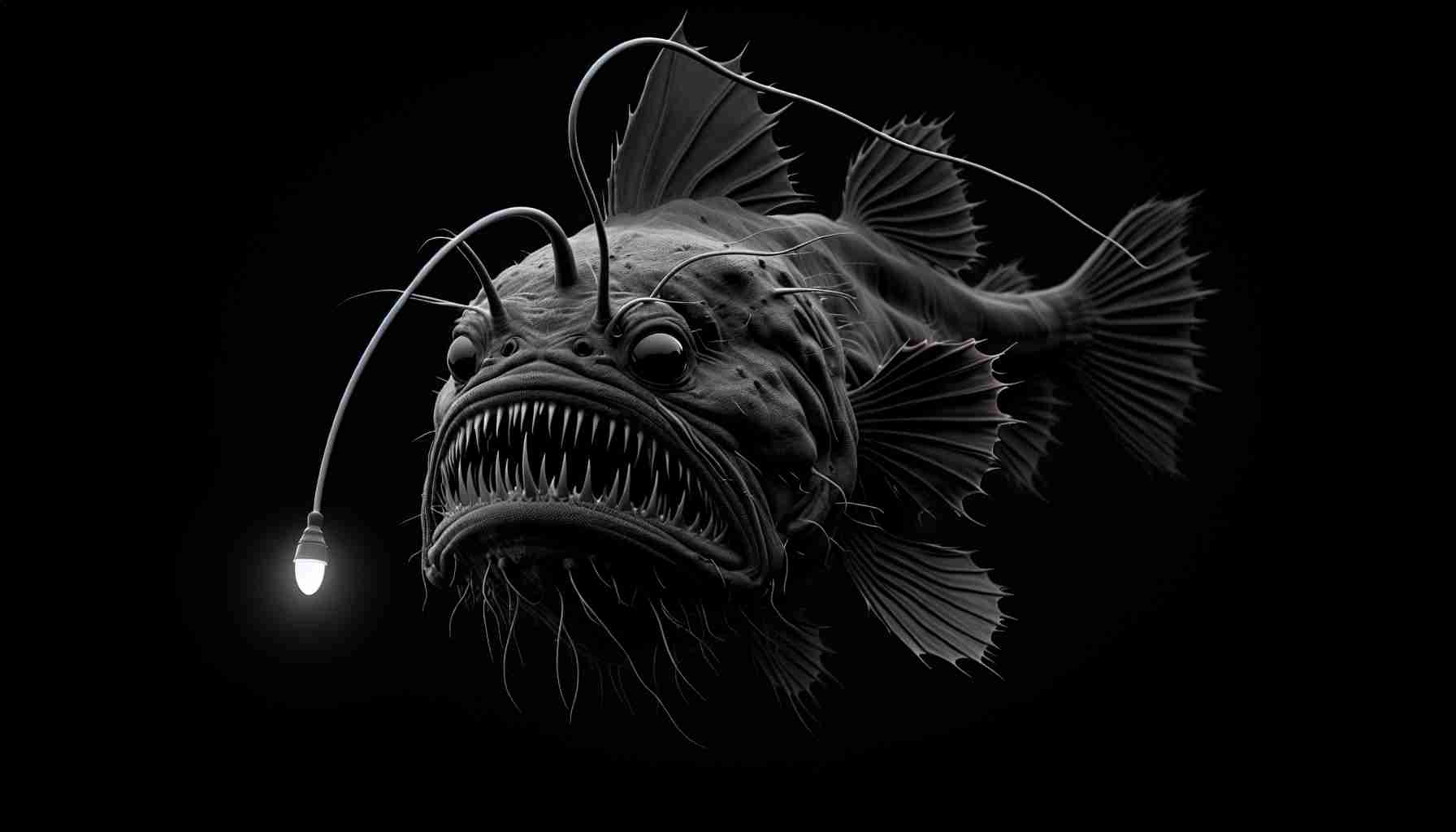- Rare encounter with a black seadevil, or humpback anglerfish, offers insight into the ocean twilight zone.
- Anglerfish may have surfaced by chance, possibly released from a predator’s grasp.
- Live observations surpass prior reliance on net-caught specimens, akin to finding oceanic gold.
- Bioluminescent bacteria aid the anglerfish in hunting, illuminating their dark habitat.
- Unique reproduction involves males permanently fusing to females to ensure genetic continuity.
- The encounter highlights the ocean’s unexplored secrets and the value of curiosity in uncovering them.
Amid the crushing depths of the ocean twilight zone, a ghostly figure flickered into view. This rare glimpse offered a fleeting but invaluable window into the shadowy world of the black seadevil, or humpback anglerfish. Moments later, this enigmatic creature vanished back into the abyss, yet the encounter whispered secrets of the deep.
The black seadevil, known for its grotesque elegance, may have found itself near the ocean’s surface by chance, perhaps the unintentional escapee of a larger predator’s grasp. Imagine a pilot whale or an opportunistic sea lion inadvertently releasing its prize, only for the anglerfish to drift toward the light—a surreal dance of survival unfolding in nature’s grim theatre.
Previously, scientists relied solely on lifeless specimens tangled in nets, relics of a time when the mysteries of the sea remained largely untapped. However, witnessing this creature alive, albeit briefly, was like striking oceanic gold. Unlike their sunlit counterparts, these black seadevils illuminate their dark realm through a stunning partnership with bioluminescent bacteria, turning the predator’s lure into a beacon.
Their life story is no less riveting. Anglerfish reproduce in a macabre spectacle, where diminutive males fuse permanently to females, each becoming a living repository of genetic material, ready to spring into the next generation’s journey through darkness.
As this haunting seadevil slips once more into obscurity, it leaves a trail of intrigue—a stark reminder of how much of the ocean’s secrets remain hidden. If we listen closely, the depths may yet reveal incredible chapters of life, waiting patiently in the silent blue. Embrace the curiosity sparked by glimpses of such elusive beauty, and venture into the unknown.
Uncovering the Ocean’s Mysteries: What You Need to Know About the Black Seadevil
Introduction
The black seadevil, or humpback anglerfish, has captivated the imaginations of those fortunate enough to catch a glimpse of this elusive creature. But what more is there to know about this fascinating denizen of the ocean’s twilight zone? In this article, we delve deeper into the world of the black seadevil, exploring aspects not covered in typical articles, such as their unique features, the pros and cons of studying them, and their significance in marine research.
Pros and Cons of Studying the Black Seadevil
Pros:
– Enhanced Understanding of Deep-Sea Ecosystems: Studying the black seadevil can provide insights into the complex ecosystems of the deep sea and the role such predators play in marine food webs.
– Bioluminescent Discoveries: The symbiotic relationship with bioluminescent bacteria can lead to advances in understanding bioluminescence and its applications in science and technology, including medical imaging and biochemical sensors.
– Evolutionary Insights: The reproductive strategies of anglerfish offer a unique case study in evolution, showcasing extreme examples of sexual dimorphism and parasitism.
Cons:
– Challenges in Observation: Due to their deep-sea habitat, direct observation is difficult, requiring specialized equipment and technology, often making it a costly and resource-intensive endeavor.
– Data Scarcity: Limited encounters mean that data collection is sporadic and opportunistic, leading to potential gaps in scientific understanding.
Market Predictions for Deep-Sea Exploration Tools
With increasing interest in the exploration of deep-sea ecosystems, the market for tools facilitating such research is poised for growth. Innovations in submersible technology and autonomous underwater vehicles (AUVs) are expected to become more affordable and precise, driving marine research forward. The industry for bioluminescence research is also likely to expand, given its potential applications across various fields.
Features and Use Cases
– Adaptive Camouflage: The black seadevil’s dark pigmentation helps it remain invisible in the dim light of its deep-sea environment. This characteristic is pivotal for conservation and stealth.
– Bioluminescent Lure: The fishing rod-like structure, tipped with a glowing bulb, serves as a predator’s tool to entice unsuspecting prey closer.
Limitations and Security Aspects
Limitations:
– Difficult Habitat: The extreme pressures and low temperatures of their deep-sea environment pose significant challenges for researchers studying these creatures in their natural habitat.
– Ethical Concerns: Capturing and studying live specimens can raise ethical questions about the potential impact on fragile deep-sea ecosystems.
Security Aspects:
– Ensuring the safety and integrity of research equipment at such depths is crucial, requiring robust materials and fail-safes to prevent loss of data or damage.
Sustainability and Environmental Impact
The exploration and study of deep-sea organisms like the black seadevil must balance scientific inquiry with environmental stewardship. It’s crucial to implement sustainable practices to minimize the impact on these fragile ecosystems, ensuring their preservation for future generations to study and admire.
FAQs About the Black Seadevil
Q: Why is the black seadevil important to study?
A: This anglerfish offers unique insights into deep-sea ecosystems, bioluminescent processes, and evolutionary adaptations, contributing to broader marine and biological understanding.
Q: How do researchers study such elusive creatures?
A: Through advanced technologies like remotely operated vehicles (ROVs) and AUVs, researchers can capture footage and samples, albeit with considerable effort and expense.
Conclusion
The encounter with the black seadevil reminds us of the ocean’s vast and largely unexplored mysteries. As ongoing research continues to unveil the secrets of the deep, the black seadevil will remain an emblem of the unseen marvels that dwell beneath the waves. Therefore, embracing technological advancements and sustainable practices will be key in unraveling these marine enigmas.
For more information on marine research and innovations, visit the main domains of established oceanic research institutions, like the NOAA or Woods Hole Oceanographic Institution.
